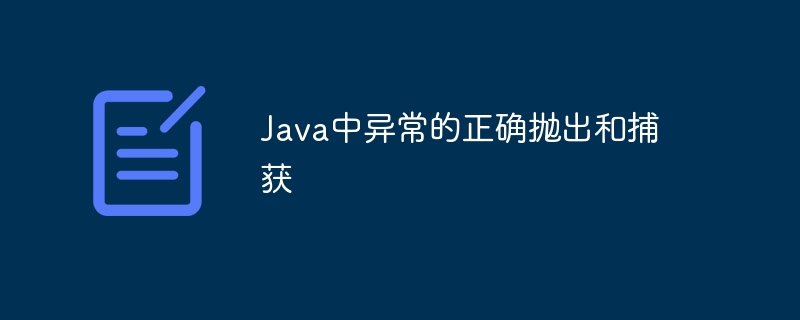Home >Java >javaTutorial >Correct throwing and catching of exceptions in Java
Correct throwing and catching of exceptions in Java
- WBOYWBOYWBOYWBOYWBOYWBOYWBOYWBOYWBOYWBOYWBOYWBOYWBOriginal
- 2024-04-30 18:36:021112browse
Exception handling in Java includes throwing and catching exceptions to ensure the robustness of the code. Throw exceptions: use the throw keyword to throw the exception type declared in the method signature; catch exceptions: use try-catch blocks to catch specific exception types and perform appropriate error handling; Notes: only throw unexpected exceptions and catch specific exceptions. Exceptions, avoid using broad types, and provide useful feedback.

Correct throwing and catching of exceptions in Java
Exceptions are errors or unusual situations that occur during program execution. Throwing and catching exceptions correctly is crucial to writing robust and reliable code.
Throwing exceptions
When an exception is detected in a method, it can be thrown using the throw keyword. The type of exception thrown must be the type explicitly declared in the method signature.
public void divide(int x, int y) throws ArithmeticException {
if (y == 0) {
throw new ArithmeticException("除数不能为0");
}
int result = x / y;
...
}Catch exceptions
Catch exceptions using a try-catch block. try blocks contain code that may throw exceptions, while catch blocks catch specific types of exceptions.
try {
divide(10, 0);
} catch (ArithmeticException e) {
System.err.println("发生除数为0的异常:" + e.getMessage());
}Notes
- Only unexpected exceptions should be thrown, and these exceptions should represent program logic errors.
- Caught exceptions should be specific to the error being handled. Avoid using overly broad types such as
ExceptionorThrowable. - After catching the exception, appropriate error handling should be performed, such as printing error information, logging, or terminating the program, etc.
Practical Example
Consider a program that reads a file and extracts data from it. If the file cannot be read, a FileNotFoundException exception is thrown.
try {
// 读取文件
Scanner scanner = new Scanner(new File("data.txt"));
...
} catch (FileNotFoundException e) {
System.err.println("找不到文件:" + e.getMessage());
// 错误处理,例如终止程序
}By throwing and catching exceptions correctly, a program can handle errors gracefully and provide useful feedback to the end user.
The above is the detailed content of Correct throwing and catching of exceptions in Java. For more information, please follow other related articles on the PHP Chinese website!

